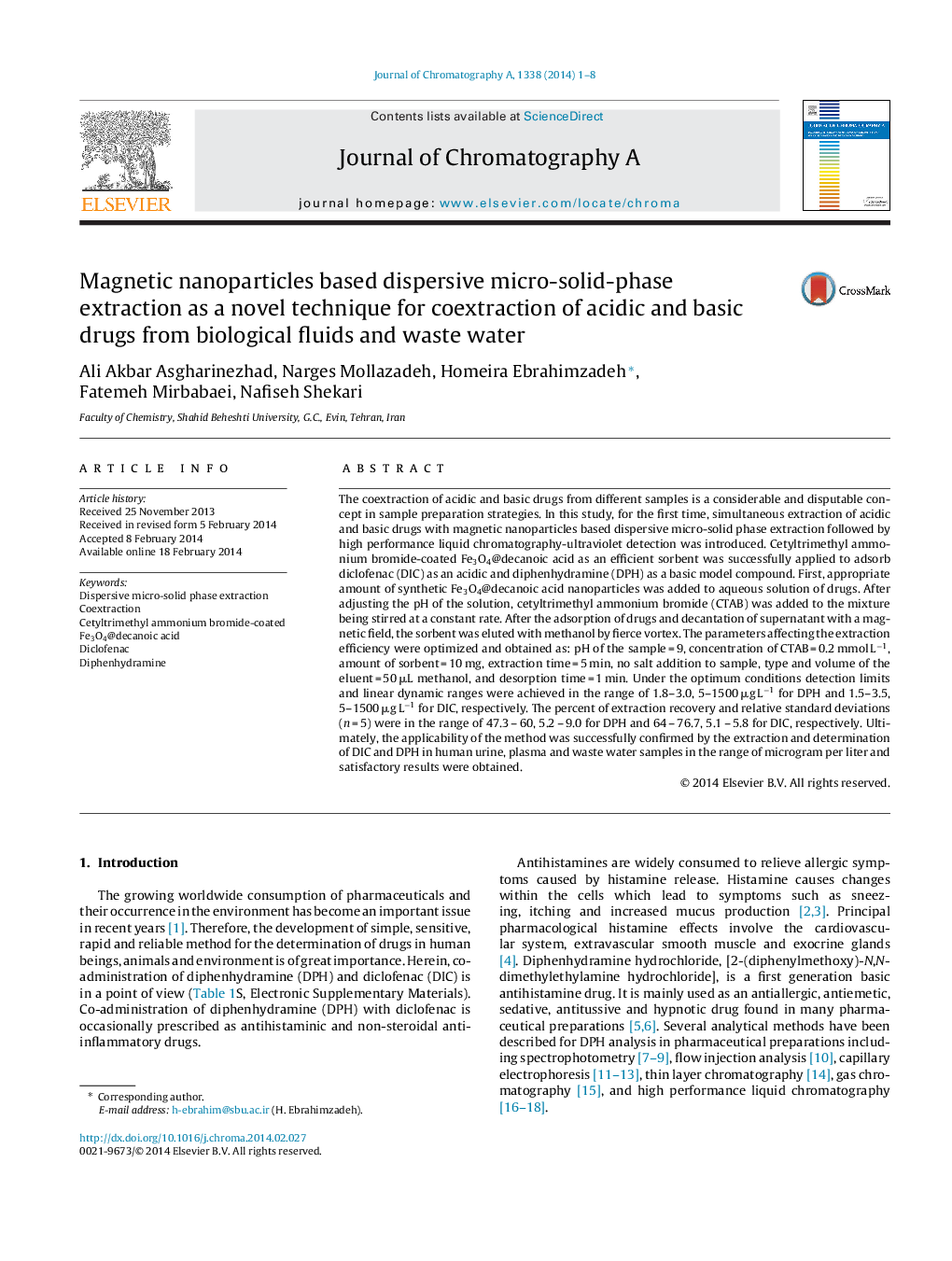| کد مقاله | کد نشریه | سال انتشار | مقاله انگلیسی | نسخه تمام متن |
|---|---|---|---|---|
| 7613351 | 1493588 | 2014 | 8 صفحه PDF | دانلود رایگان |
عنوان انگلیسی مقاله ISI
Magnetic nanoparticles based dispersive micro-solid-phase extraction as a novel technique for coextraction of acidic and basic drugs from biological fluids and waste water
ترجمه فارسی عنوان
استخراج نانوذرات مغناطیسی پراکنده با میکرو جامد به عنوان یک تکنیک جدید برای استخراج مواد اولیه اسیدی و اساسی از مایعات بیولوژیکی و فاضلاب
دانلود مقاله + سفارش ترجمه
دانلود مقاله ISI انگلیسی
رایگان برای ایرانیان
کلمات کلیدی
موضوعات مرتبط
مهندسی و علوم پایه
شیمی
شیمی آنالیزی یا شیمی تجزیه
چکیده انگلیسی
The coextraction of acidic and basic drugs from different samples is a considerable and disputable concept in sample preparation strategies. In this study, for the first time, simultaneous extraction of acidic and basic drugs with magnetic nanoparticles based dispersive micro-solid phase extraction followed by high performance liquid chromatography-ultraviolet detection was introduced. Cetyltrimethyl ammonium bromide-coated Fe3O4@decanoic acid as an efficient sorbent was successfully applied to adsorb diclofenac (DIC) as an acidic and diphenhydramine (DPH) as a basic model compound. First, appropriate amount of synthetic Fe3O4@decanoic acid nanoparticles was added to aqueous solution of drugs. After adjusting the pH of the solution, cetyltrimethyl ammonium bromide (CTAB) was added to the mixture being stirred at a constant rate. After the adsorption of drugs and decantation of supernatant with a magnetic field, the sorbent was eluted with methanol by fierce vortex. The parameters affecting the extraction efficiency were optimized and obtained as: pH of the sample = 9, concentration of CTAB = 0.2 mmol Lâ1, amount of sorbent = 10 mg, extraction time = 5 min, no salt addition to sample, type and volume of the eluent = 50 μL methanol, and desorption time = 1 min. Under the optimum conditions detection limits and linear dynamic ranges were achieved in the range of 1.8-3.0, 5-1500 μg Lâ1 for DPH and 1.5-3.5, 5-1500 μg Lâ1 for DIC, respectively. The percent of extraction recovery and relative standard deviations (n = 5) were in the range of 47.3 - 60, 5.2 - 9.0 for DPH and 64 - 76.7, 5.1 - 5.8 for DIC, respectively. Ultimately, the applicability of the method was successfully confirmed by the extraction and determination of DIC and DPH in human urine, plasma and waste water samples in the range of microgram per liter and satisfactory results were obtained.
ناشر
Database: Elsevier - ScienceDirect (ساینس دایرکت)
Journal: Journal of Chromatography A - Volume 1338, 18 April 2014, Pages 1-8
Journal: Journal of Chromatography A - Volume 1338, 18 April 2014, Pages 1-8
نویسندگان
Ali Akbar Asgharinezhad, Narges Mollazadeh, Homeira Ebrahimzadeh, Fatemeh Mirbabaei, Nafiseh Shekari,
